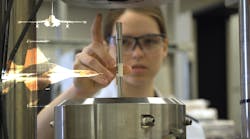A steel alloy developed at the Air Force Research Laboratory, called AF-9628, has the strength and toughness needed for aerospace parts. The alloys costs less than some other high-performance steel alloys, including Eglin Steel and HP-9-4-20; however, it is more expensive than common grades used in conventional munitions. AF-9628 is unique in that it does not contain tungsten, which is found in Eglin Steel, or cobalt, which is found in HP-9-4-20.
The lab determined that AF-9628 is a good material for additive manufacturing due to its high strength. The lab tested the alloy using a powder bed fusion 3D printing machine. The AF-9628 powder melted predictably in the machine and finished parts met benchmarks for porosity, strength, and impact toughness right out of the machine. No post-processing was needed.
Many tested alloys don’t take to additive manufacturing very well, according to the researchers. For example, certain alloys will not melt and then crack a lot once you actually try to make a part.
The researchers first created simple parts, then complex designs including several intricate projectiles. They then used two machines and printed about 130 articles, including 30 small cylinders, 60 larger cylinders, 20 tensile bars, and 20 impact specimens.
For now, the AF-9628 powder is only available in small production quantities and companies can take months to formulate it. As such, while AF-9628 is a less-expensive steel, the powder form does not result in the same cost savings since the demand is low. The AF researchers hope this early success will lead to increased interest in high-strength steels. There’s not a lot of steels research and ongoing studies involve mostly titanium and composites.

